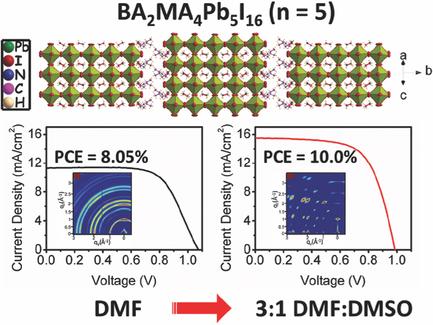当前位置:
X-MOL 学术
›
Adv. Energy Mater.
›
论文详情
Our official English website, www.x-mol.net, welcomes your feedback! (Note: you will need to create a separate account there.)
Understanding Film Formation Morphology and Orientation in High Member 2D Ruddlesden–Popper Perovskites for High‐Efficiency Solar Cells
Advanced Energy Materials ( IF 27.8 ) Pub Date : 2017-09-01 , DOI: 10.1002/aenm.201700979 Chan Myae Myae Soe 1, 2 , Wanyi Nie 2 , Constantinos C. Stoumpos 1 , Hsinhan Tsai 2 , Jean‐Christophe Blancon 2 , Fangze Liu 2 , Jacky Even 3 , Tobin J. Marks 1 , Aditya D. Mohite 2 , Mercouri G. Kanatzidis 1
Advanced Energy Materials ( IF 27.8 ) Pub Date : 2017-09-01 , DOI: 10.1002/aenm.201700979 Chan Myae Myae Soe 1, 2 , Wanyi Nie 2 , Constantinos C. Stoumpos 1 , Hsinhan Tsai 2 , Jean‐Christophe Blancon 2 , Fangze Liu 2 , Jacky Even 3 , Tobin J. Marks 1 , Aditya D. Mohite 2 , Mercouri G. Kanatzidis 1
Affiliation

|
2D Ruddlesden–Popper (RP) perovskites have recently emerged as promising candidates for hybrid perovskite photovoltaic cells, realizing power‐conversion efficiencies (PCEs) of over 10% with technologically relevant stability. To achieve solar cell performance comparable to the state‐of‐the‐art 3D perovskite cells, it is highly desirable to increase the conductivity and lower the optical bandgap for enhanced near‐IR region absorption by increasing the perovskite slab thickness. Here, the use of the 2D higher member (n = 5) RP perovskite (n‐butyl‐NH3)2(MeNH3)4Pb5I16 in depositing highly oriented thin films from dimethylformamide/dimethylsulfoxide mixtures using the hot‐casting method is reported. In addition, they exhibit superior environmental stability over thin films of their 3D counterpart. These films are assembled into high‐efficiency solar cells with an open‐circuit voltage of ≈1 V and PCE of up to 10%. This is achieved by fine‐tuning the solvent ratio, crystal growth orientation, and grain size in the thin films. The enhanced performance of the optimized devices is ascribed to the growth of micrometer‐sized grains as opposed to more typically obtained nanometer grain size and highly crystalline, densely packed microstructures with the majority of the inorganic slabs preferentially aligned out of plane to the substrate, as confirmed by X‐ray diffraction and grazing‐incidence wide‐angle X‐ray scattering mapping.
中文翻译:

了解用于高效太阳能电池的高员2D Ruddlesden-Pop钙钛矿中的膜形成形态和取向
二维Ruddlesden-Popper(RP)钙钛矿最近成为混合钙钛矿光伏电池的有前途的候选者,实现了超过10%的功率转换效率(PCE)并具有技术上的稳定性。为了达到与最新3D钙钛矿电池可比的太阳能电池性能,非常需要增加电导率并降低光学带隙,以通过增加钙钛矿平板厚度来增强近红外区域吸收率。在此,使用2D较高级成员(n = 5)RP钙钛矿(n-丁基-NH 3)2(MeNH 3)4 Pb 5 I 16据报道采用热浇铸法从二甲基甲酰胺/二甲基亚砜混合物中沉积高取向薄膜。此外,与3D对应的薄膜相比,它们具有出色的环境稳定性。这些薄膜被组装成高效太阳能电池,其开路电压约为1 V,PCE高达10%。这可以通过微调薄膜中的溶剂比率,晶体生长方向和晶粒尺寸来实现。经过优化的设备的性能增强归因于微米级晶粒的生长,而不是更通常获得的纳米级晶粒尺寸和高度结晶的致密堆积的微观结构,其中大多数无机平板优先与基材平面对齐。
更新日期:2017-09-01
中文翻译:

了解用于高效太阳能电池的高员2D Ruddlesden-Pop钙钛矿中的膜形成形态和取向
二维Ruddlesden-Popper(RP)钙钛矿最近成为混合钙钛矿光伏电池的有前途的候选者,实现了超过10%的功率转换效率(PCE)并具有技术上的稳定性。为了达到与最新3D钙钛矿电池可比的太阳能电池性能,非常需要增加电导率并降低光学带隙,以通过增加钙钛矿平板厚度来增强近红外区域吸收率。在此,使用2D较高级成员(n = 5)RP钙钛矿(n-丁基-NH 3)2(MeNH 3)4 Pb 5 I 16据报道采用热浇铸法从二甲基甲酰胺/二甲基亚砜混合物中沉积高取向薄膜。此外,与3D对应的薄膜相比,它们具有出色的环境稳定性。这些薄膜被组装成高效太阳能电池,其开路电压约为1 V,PCE高达10%。这可以通过微调薄膜中的溶剂比率,晶体生长方向和晶粒尺寸来实现。经过优化的设备的性能增强归因于微米级晶粒的生长,而不是更通常获得的纳米级晶粒尺寸和高度结晶的致密堆积的微观结构,其中大多数无机平板优先与基材平面对齐。


























 京公网安备 11010802027423号
京公网安备 11010802027423号